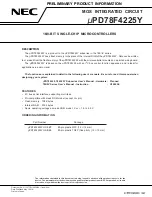
Lithionics Battery LLC |2013
If you have a Wireless Remote Control, Maintenance Charging will be Required Using a
Lithionics Battery CHARGER as the Wireless Remote Control will Draw Power from the
Battery During Periods of Non-Use. Charge Your Battery Every 30 Days!
4. Charging Your Battery
4.1 - Supported chargers:
Lithionics Battery 12V engine start batteries can be charged with either a 12V rated alternator in
proper working order or a Lithionics Battery LiFePO4 Charger. Failure to do so
will
void the battery’s
warranty. Other chargers are factory approved but you must report that charger to the factory in an
email request to your sales representative or
and obtain formal approval.
4.2 - Connecting Your Battery to a Charger:
Step 1.
Verify that the battery output is ON. This can be done by checking that the red pushbutton LED is lit or
by checking that battery voltage is present with a multi-meter. Pressing the ON-OFF button for 1 full
second will always turn the battery ON whether it is ON or OFF.


























